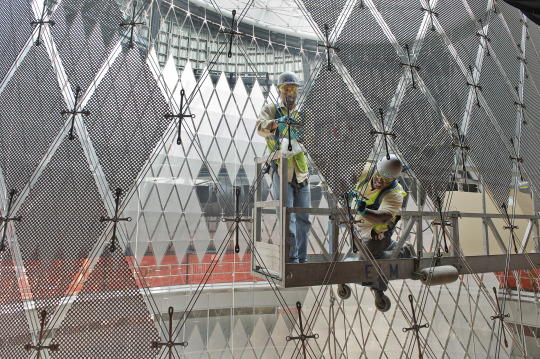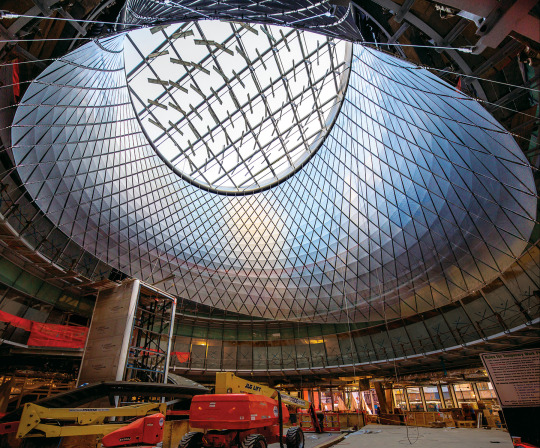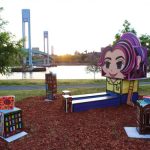FELLOWS AT 30: INTERVIEW WITH JAMES CARPENTER
The goal is to integrate, within even the most urban environments, a powerful collective experience of light
On Thursday August 13 NYFA continues its 30th Anniversary celebration with the opening of Triacontagon: A Celebration of 30 Years of the Artists’ Fellowship Program. To highlight
Triacontagon, exhibiting artist and NYFA Fellow in Crafts ‘90 James Carpenter spoke to us about his experience with NYFA over the years.
Triacontagon is a traveling exhibition premiering at Westbeth Gallery featuring 41 NYFA Fellows:
Exhibition Dates: Thursday, August 13 – Sunday, August 30
Exhibition Location: Westbeth Gallery, 55 Bethune Street, New York, NY 10014
Opening Reception: Thursday, August 13, 7:00 PM – 9:00 PM
Gallery Hours: Wednesday through Sunday, 1 – 6 PM
James Carpenter is a light artist and designer based in New York City.
NYFA: Can you recall any projects or aspirations
that your 1990 Fellowship in Crafts enabled you to accomplish and what impact
did your Fellowship award have on you?
And, how has the climate changed for artists since you received your
award?
JC: At that time, I was exploring the potential for integrating
light and structure, using glass as a structural element within sculptural
assemblies. The ultimate goal was to someday apply structural glass to the
creation of seamless architecture informed by light. This required some
exploration outside of commissioned opportunities as the research necessary was
largely non-existent. The NYFA Fellowship played a small but important role in
supporting my studio’s cutting edge and foundational work – the extraordinary
use of structural glass seen in Apple stores across the world could be seen as one
progeny of that work.
NYFA: As an inaugural member of the Artists
Advisory Committee, who’s charge it was to help develop and guide the
Fellowships program, do you recall working with other members, such as Yvonne
Rainer and Mary Roehm to name a few, and what was that experience like? What made you want to be a part of NYFA’s
Artist Advisory Committee?
JC: As an inaugural member of the advisory committee, I can say
that each of us brought our knowledge of which individuals in our related
fields were pushing the envelope, which artists were advancing and generating
change – the Foundation’s support provided the impetus for change.
NYFA: You’ve been working in glass for over 30
years, what’s so unique about that medium for you?
JC: More than any other material, glass has
the unique ability to add texture and responsiveness to the built environment
in ways that enhance the human experience of constructed space. Since I first
began working with glass as a young artist, I’ve been fascinated by its
capacity to harness the volumetric and performative dimensions of natural light,
which has always been the foundational element of my practice. Because of its
transparency, people often think of glass as merely an interstitial material;
in fact, it’s an incredibly dynamic medium that can mediate a dialogue between
interior and exterior space.

NYFA: On your own work, how do you go about
designing important public spaces such as your piece “Sky Reflector-Net” at the
Fulton Street station in Lower Manhattan or Israel’s National Museum?
JC: When we were commissioned by the
MTA Arts and Design to create an artwork for the Fulton Center’s central atrium
space, our goal was to expand the image of the sky visible
through the oculus skylight, enfolding travelers in an almost visceral experience
of light and connecting urban dwellers to its diurnal and seasonal activity. To implement this
design, we worked closely with the architects of the Fulton Center, Grimshaw
Architects, and the project engineers, ARUP. As is typical of these
collaborations, JCDA provided an organizing vision throughout the planning and
construction process to ensure that the artistic and practical goals for the
space were fully realized in the finished product.
For the Israel Museum in Jerusalem,
JCDA was invited by the museum’s director, James Snyder,
to envision an expansion to its existing
facility. James was aware of our experience in creating
large-scale built environments that advance practical
objectives with an artistic design sensibility.
In this instance, we proposed an expansion to the original Alfred
Mansfeld design that addressed the IMJ’s goals of improving
circulation and wayfinding by creating sequences, spaces,
and enclosures that would reconnect visitors to the
museum’s extraordinary site. Our plan to reorganize elements of the campus and
create a new circulation spine was accepted, and we
led the museum’s renewal, creating four glass pavilions that reconnected
the museum with a powerful sense of the 20-acre campus landscape while
precisely moderating the Mediterranean light levels. The visitor
experience became both rationalized and enhanced, with
the refined qualities of light providing an intuitive sense of direction
throughout the space and supporting a
heightened state of observation essential to the experience of the collection.
NYFA: What projects are you currently working on?
JC: Our recent and upcoming projects
reflect my firm’s evolution from creating design
features embedded in larger environments to defining the public realm
through the design of large-scale spaces.
We are currently designing the expansion of the Museum for
Westward Expansion in St. Louis, MO, a museum that is situated below the St.
Louis Arch. We are also designing the new Bornholms Museum in Denmark, which is
a merging of two local museums unified by an emphasis on light as a defining
characteristic of the local art and culture.
This fall, another of our projects for the University of
Chicago will be completed: a multi-disciplinary physics building known as the
William Eckhardt Research Center, for which we
designed the building envelope and collaborated with the architecture firm HOK
to create public spaces within the building that would be informed by the
experience of light.
Two commercial towers for which we led the design are also
nearing completion. One is in Sydney, Australia and the other is here in New
York along the High Line. Both these and all our projects seek to establish a
performative architecture, where innovative structures are both economically
viable and culturally valuable. The goal
is to integrate, within even the most urban environments, a powerful collective
experience of light – one that engages the individual with a transcendent
connection to nature.
Images, from top: “Sky Reflector-Net” Fulton Center, New York, NY © David Sundberg; “Sky Reflector-Net” Fulton Center, New York, NY © Patrick Cashin





